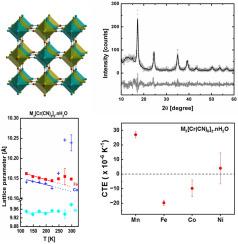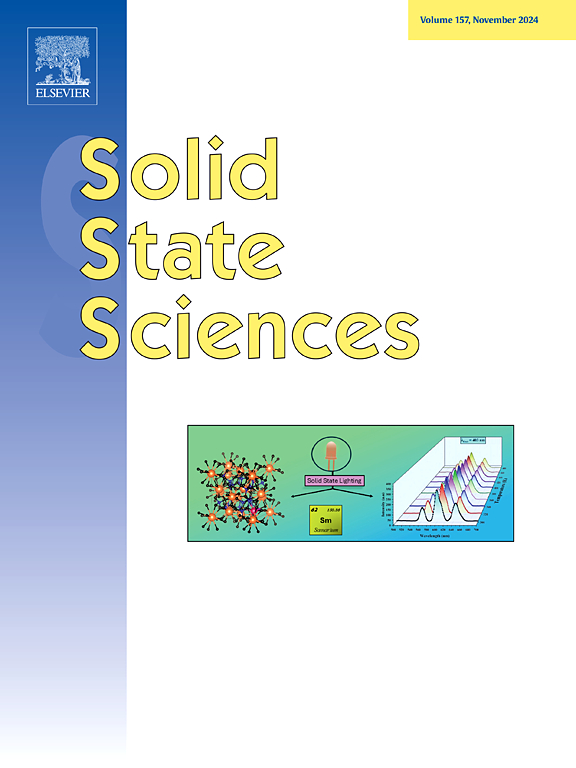Thermal expansion in Prussian Blue analogs M3[Cr(CN)6]2.nH2O (M = Mn, Fe, Co, Ni)
IF 3.4
3区 化学
Q2 CHEMISTRY, INORGANIC & NUCLEAR
引用次数: 0
Abstract
Thermal expansion in Prussian Blue Analogs (PBAs) M3[Cr(CN)6]2.nH2O (M = Mn, Fe, Co, Ni; n = 10–16) was studied using powder X-ray diffraction (XRD) as a function of temperature in the range 123–298 K. Standard chemical precipitation was used to prepare the materials and they were characterized using standard characterization techniques XRD, X-ray fluorescence (XRF), thermogravimetric analysis (TGA) and Fourier transform infrared (FTIR) spectroscopy. All materials were found to crystallize in the cubic structure with space group . Strong compositional dependence of thermal expansion is found in this series of PBAs. While Mn3[Cr(CN)6]2.12H2O and Ni3[Cr(CN)6]2.16H2O show positive thermal expansion (PTE) behavior the other two PBAs, Fe3[Cr(CN)6]2.10H2O and Co3[Cr(CN)6]2.14H2O, show strong negative thermal expansion (NTE) behavior with as large coefficient of thermal expansion (CTE) as −19.7 x 10−6 K−1 (for M = Fe) in the temperature range 123–223 K. For the PBAs showing NTE, the magnitude of NTE coefficients can be correlated with the trends for M cation size and cell (or lattice) parameter.

普鲁士蓝类似物 M3[Cr(CN)6]2.nH2O(M = Mn、Fe、Co、Ni)的热膨胀率
使用粉末 X 射线衍射 (XRD) 研究了普鲁士蓝类似物(PBAs)M3[Cr(CN)6]2.nH2O(M = Mn、Fe、Co、Ni;n = 10-16)在 123-298 K 范围内的热膨胀与温度的函数关系。制备材料时使用了标准化学沉淀法,并使用标准表征技术 XRD、X 射线荧光 (XRF)、热重分析 (TGA) 和傅立叶变换红外光谱 (FTIR) 对材料进行了表征。所有材料均为立方结构,空间群为 Fm3-‾m。在这一系列 PBA 中,发现热膨胀与成分有很强的相关性。Mn3[Cr(CN)6]2.12H2O 和 Ni3[Cr(CN)6]2.16H2O 表现出正热膨胀 (PTE) 行为,而另外两种 PBA,Fe3[Cr(CN)6]2.10H2O 和 Co3[Cr(CN)6]2.14H2O 则表现出强烈的负热膨胀 (NTE) 行为,热膨胀系数 (CTE) 大至 -19.对于显示 NTE 的 PBA,NTE 系数的大小与 M 阳离子尺寸和晶胞(或晶格)参数的变化趋势相关。
本文章由计算机程序翻译,如有差异,请以英文原文为准。
求助全文
约1分钟内获得全文
求助全文
来源期刊

Solid State Sciences
化学-无机化学与核化学
CiteScore
6.60
自引率
2.90%
发文量
214
审稿时长
27 days
期刊介绍:
Solid State Sciences is the journal for researchers from the broad solid state chemistry and physics community. It publishes key articles on all aspects of solid state synthesis, structure-property relationships, theory and functionalities, in relation with experiments.
Key topics for stand-alone papers and special issues:
-Novel ways of synthesis, inorganic functional materials, including porous and glassy materials, hybrid organic-inorganic compounds and nanomaterials
-Physical properties, emphasizing but not limited to the electrical, magnetical and optical features
-Materials related to information technology and energy and environmental sciences.
The journal publishes feature articles from experts in the field upon invitation.
Solid State Sciences - your gateway to energy-related materials.
 求助内容:
求助内容: 应助结果提醒方式:
应助结果提醒方式:


